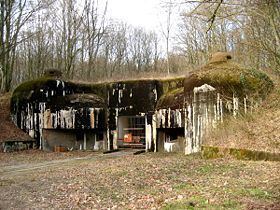Open tothe public Surface only Built by CORF | Condition Flooded | |
 | ||
Materials Concrete, steel, deep excavation Similar Ouvrage Soetrich, Ouvrage Molvange, Ouvrage Métrich, Ouvrage Bois‑Karre, Ouvrage Galgenberg | ||
Ouvrage Kobenbusch is a gros ouvrage of the Maginot Line, located in the Fortified Sector of Thionville in the Cattenom forest. It possesses seven combat blocks and two entrance blocks, one for ammunition and the other for men. It is located between petit ouvrage Bois-Karre and petit ouvrage Oberheid, and was named for the surrounding Kobenbusch forest. The position saw little action during World War II. Its deep passages have been flooded by the construction of a cooling water lake for a nearby nuclear power plant, but its surface features are being developed with an interpretive path through the surrounding forest.
Contents
Design and construction
The Kobenbusch position forms the point of the Cattenom salient, where the east-west defensive line turns to the south. The site was surveyed by CORF (Commission d'Organisation des Régions Fortifiées), the Maginot Line's design and construction agency, in 1930. Work by the contractor Verdun-Fortifications began in 1931, and the position became operational in 1935, at a cost of 65 million francs. Kobenbusch was served by a 60 cm-gauge narrow-gauge railway, which enters at the munitions entrance and runs all the way out through the galleries to the combat blocks. On the surface, the railway connects to supply points to the rear and to other ouvrages.
Description
Kobenbusch is a relatively compact gros ouvrage, with a short main gallery leading in from the munitions and personnel entrances past to underground barracks to the combat blocks. Unusually for a gros ouvrage, it possesses no "M1" main ammunition magazine.
.
Casemates and shelters
The Abri du Bois-de-Cattenom is nearby to the west, and may be visited. There are no other casemates, observation points or shelters associated with Kobenbusch, although the petit ouvrage Oberheid is close at hand on the east.
Manning
The manning of the ouvrage in 1940 comprised 513 men and 14 officers of the 169th Fortress Infantry Regiment and the 151st Position Artillery Regiment. The units were under the umbrella of the 42nd Fortress Corps of the 3rd Army, Army Group 2. The commandant de l'ouvrage in 1940 was Commandant Charnal. The Casernement de Cattenom provided peacetime above-ground barracks and support services to Kobenbusch and other ouvrages in the area.
History
See Fortified Sector of Thionville for a broader discussion of the events of 1940 in the Thionville sector of the Maginot Line.Kobenbusch did not see significant action in the Battle of France in 1940, nor in the Lorraine Campaign of 1944. Kobenbusch provided suppressing fire against German infiltrators on the surface of Oberheid. About the same time, a party of Germans infiltrated the area of Kobenbusch Block 5. The Germans largely bypassed the area, advancing along the valley of the Meuse and Saar rivers, threatening the rear of the Thionville sector. An order to fortress troops by sector commander Colonel Jean-Patrice O'Sullivan to prepare for withdrawal on 17 June was reversed by O'Sullivan. The garrison therefore remained in place. Following negotiations, the positions on the left bank of the Moselle finally surrendered to the Germans on 30 June 1940.
Present status
While the entry and combat blocks remain visible, the underground galleries, barracks, ammunition magazine and utility areas, which lie at an average depth of 30 meters (98 ft) below the surface, have been flooded by the cooling water lake of the nearby Cattenom Nuclear Power Plant. The site has been owned by EDF since the construction of the power plant in 1981. It is maintained by the Association Ligne Maginot du Secteur Fortifié du Bois de Cattenom, which manages Bois Karre, the Abri du Bois de Cattenom, Ouvrage Sentzich and Ouvrage Galgenberg. A pedestrian path through the surface installation is under development, and the Abri du Bois de Cattenom may be visited at times.
